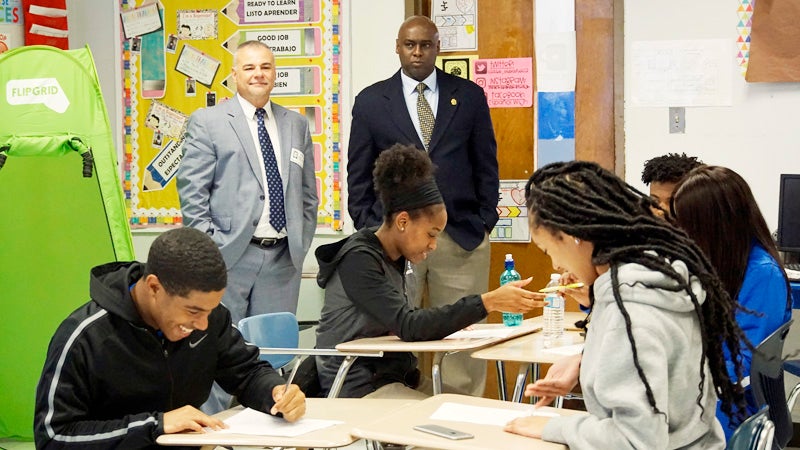WSJH student success amid disadvantages seen as guiding light for rest of state
Published 12:09 am Wednesday, March 27, 2019

- West St. John High School principal Claude Hill, back right, takes Dr. Keith Leger, Director of Education Policy and Government Affairs for the CABL, back left, inside an Edgard classroom.
EDGARD — The Council for A Better Louisiana visited West St. John High School this month to learn from the school’s success in the hopes of duplicating those efforts across the state, school district officials said.
The council is visiting some of the 112 schools in the state that have attained an A or B letter grade while educating a 75 percent or more economically disadvantaged student population.
The purpose is to provide an opportunity for legislators to recognize the achievement happening at these schools and take the data gathered to compile a case study to see what is working in these low-income, high-achieving schools and to then share that information with other schools facing the same challenges.
Dr. Keith Leger, Education Policy and Government Affairs director for CABL, said policymakers are often incorrectly told poor children can’t learn and low-income schools shouldn’t be held to the same standards as other schools.
“I knew that was a false narrative, so one of the things we set out to do was prove that narrative was not true and that poverty is not a learning disability and it should never be used as an excuse,” Leger said. “So we set out to find high-poverty, high-performing schools like West St. John. What you are all doing is disproving those folks. You’re bucking the trend line.”
WSJH’s percentage of students classified as economically disadvantaged is even higher than CABL’s threshold, at around 95 percent, but that hasn’t kept the school from earning big accolades.

St. John the Baptist Parish School Board member Charo Holden, right, listens as West St. John High School Principal Claude Hill talks about what is done at the school to ensure student success.
“You have a very high rate of graduation and of students who go on to college,” Leger said. “What do you do at West St. John High that others might not do?”
The school was recently named an Equity Honoree by the Louisiana Department of Education for outperforming 90 percent of all schools in the state among African-American students. It’s been ranked in the top nationally by U.S. New & World Report and Newsweek.
But although West St. John has been recognized on multiple occasions for its success in educating economically disadvantaged students it’s not a term that’s used at the school.
“I don’t think our students know they are in a low socio-economic classification,” principal Claude Hill said. “That’s not a moniker we use.”
Outside of curriculum, culture and parental involvement, discussion topics with the West St. John High School leadership team included:
• Components of leading a school with a high percentage of economically disadvantaged students
• Programs leading to school success
• Professional development
• Skillsets sought when hiring teachers
• What’s done to ensure all students are on track to graduate
Of particular interest is the school’s success with students off to post-secondary education.
The school’s graduation rate for the 2016-17 was more than 95 percent, and nearly every student moves on to technical school, college or the military, district officials said.
Hill said the school is willing to give up class time to expose students to opportunities they might otherwise never experience through college visits, job fairs and visits by professionals to the school.
Vice Principal Kendria Spears said she also discusses where students want to go after high school as soon as they arrive on campus so that they can set goals and review their transcripts and test scores in order to attain those goals by graduation.
“The biggest component is passion and getting them to believe in the possibilities,” Hill said. “We have all come from a public school education at some point, and if we can do it you can do it, so we’re speaking from walking those halls.”
West St. John leaders emphasize they want to help, meet students where they are and fill in the gaps by showing students they care. Demonstrate to students ways to build relationships with fellow students and staff members.
“Don’t use socio-economic status as an excuse,” School Board member Charo Holden said.
“Show them that you do care and, for the time being, when you’re in my classroom I will be that parent figure. Make sure they are comfortable with you so they can come to you in whatever aspect they need.”




